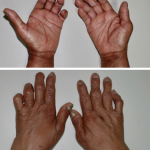This case still haunts me: Did this lymphoma present atypically at the patient’s first evaluation? Did it evolve over time, or was it simply unrelated to the urticaria. This frustrating property of our diseases—to transmogrify at will—is another characteristic that tethers it to the basilisk.
Second, unlike zebras, whose characteristic equine appearance can be appreciated by even small children, basilisks are chimeric in nature and morph into different forms depending on the hunter’s expectations and perspectives. Basilisks are much more similar to rheumatic conditions; we haven’t the faintest idea how these difficult diseases are supposed to present.
Eosinophilic granulomatosis with polyangiitis (EGPA) is a good example of this. To the rheumatologist, the disease is a small-vessel vasculitis associated with eosinophilia. To the allergist/immunologist, it’s a hypereosinophilic disorder with vasculitic features. And to the pulmonologist, it’s a systemic presentation of severe persistent asthma. Which is the true form and contour of this multifaceted beast? Who really knows, but I guarantee it’s not a four-legged, dichromatic ruminant.
Even relatively common diseases, such as osteoarthritis and gout, have pathogeneses that are shrouded in mystery. The closer we examine these conditions, the more inscrutable they appear. We depend on age-old tales and myths, like tales of the basilisk, to characterize their signs and symptoms, but the veracity of this traditional knowledge is dubious..
Third, few physicians I know are eager to spot a basilisk. Yes, there are a few enthusiasts and daredevils who relish the hunt, but most of us encounter basilisks entirely accidentally in the most unexpected and mundane places. There are a couple of reasons for this. Basilisk hunts are extremely unsatisfying. In only a small proportion of cases will there be a definitive answer. Other times, we have to deal with mealy-mouthed phrases like idiopathic or undifferentiated.
Also, few lessons can be learned from basilisk hunting. It may be intellectually satisfying to capture a dreaded beast, but because they are so rare, it’s hard to take away the right messages. I’m sure every fellow and resident has heard their attending physician’s story about how there’s one arcane question you should ask every patient because asking it one time led to a diagnosis. Although these make for great stories, the lessons are often inapplicable.
Final Thoughts
The zebra adage comes from a different time, when the list of diagnoses was long, but the list of available treatments was short. In this day and age, rheumatologists are tasked with identifying the beasts lurking in the foreground, and devising management and treatment strategies to subdue them. Here is where diseases become even more dreadful than basilisks. The treatment strategies we currently have are mercurial creatures in their own right. A loaded rifle in the hands of a keen-eyed hunter may take down a zebra, but what in the world can take down a creature whose basic constitution is unknown?
Without giving away any spoilers, Harry Potter and his friends eventually triumph against the basilisk. But they don’t do it alone. The wise counsel of their teachers, the sincerity with which they studied what little was known about the creature and informed speculation, partly based on intuition, enabled them to prevail. That is perhaps the biggest takeaway of basilisk hunting: A proper education, whether in wizardry or medicine, is the best weapon to stalk, subdue and slay dangerous beasts.


